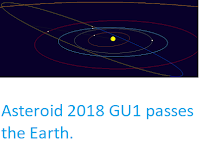Asteroid 2018 GE3 passed by the Earth at a distance of about 193 000
km (0.50 times the average distance between the Earth and the Moon, or
0.13% of the distance between the Earth and the Sun), slightly after 6.40 am
GMT on Sunday 15 April 2018. There was no danger of
the asteroid hitting us, though were it to do so it would have
presented a significant threat. 2018 GE3 has an estimated
equivalent
diameter of 33-100 m (i.e. it is estimated that a spherical object
with
the same volume would be 33-100 m in diameter), and an object at the
upper end of this range would be predicted to be capable of
passing through the Earth's
atmosphere relatively intact, impacting the ground directly with an
explosion that would be about 225 times as powerful as the
Hiroshima
bomb. Such an impact would result in an impact crater over a kilometre
in
diameter
and devastation on a global scale, as well as climatic effects that
would last years or even decades.
Asteroid 2018 GE3 passing in front of the constellation of Serpens on 14 April 2018, as seen from Weißenkirchen in Austria. Michael Jäger/Space.
2018 GE3 was discovered on 14 April 2018 (the day before its closest approach to the Earth) by the University of Arizona's Catalina Sky Survey,
which is located in the Catalina Mountains north of Tucson. The
designation 2018 GE3 implies that it was the 80th asteroid (asteroid E3)
discovered in the first half of April 2018 (period 2018 G).
2018 GE3 has a 918 day orbital period and an eccentric orbit
tilted at an angle of 8.74° to the plane of the Solar System, which
takes it from 0.32 AU from the Sun (i.e. 32% of he average distance at
which the Earth orbits the Sun, inside the orbit of the planet Mercury) to 3.38 AU from the Sun (i.e. 338% of
the
average distance at which the Earth orbits the Sun, and more than twice as distant from the Sun as the planet Mars). It is therefore
classed as an
Apollo Group Asteroid (an asteroid that is on average further from the
Sun than the Earth, but which does get closer). This means that close
encounters between the asteroid and Earth are extremely common, with the
last having occurred in December 2015 and the next predicted
in December 2020.
See also...
Follow Sciency Thoughts on Facebook.








